
Satureja is a genus of aromatic plants of the family Lamiaceae, related to rosemary and thyme. It is native to North Africa, southern and southeastern Europe, the Middle East, and Central Asia. A few New World species were formerly included in Satureja, but they have all been moved to other genera. Several species are cultivated as culinary herbs called savory, and they have become established in the wild in a few places.

Geum, commonly called avens, is a genus of about 50 species of rhizomatous perennial herbaceous plants in the rose family and its subfamily Rosoideae, widespread across Europe, Asia, North and South America, Africa, and New Zealand. They are closely related to Potentilla and Fragaria. From a basal rosette of leaves, they produce flowers on wiry stalks, in shades of white, red, yellow, and orange, in midsummer. Geum species are evergreen except where winter temperatures drop below 0 °F (−18 °C). The cultivars 'Lady Stratheden', and 'Mrs J. Bradshaw' have gained the Royal Horticultural Society's Award of Garden Merit.

Clinopodium is a genus of flowering plants in the family Lamiaceae. It is in the tribe Mentheae of the subfamily Nepetoideae, but little else can be said with certainty about its phylogenetic position.

Clinopodium grandiflorum, the large-flowered calamint, showy calamint or mint savory, is a species of ornamental plant.
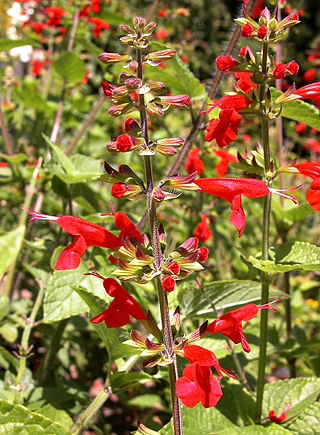
Salvia coccinea, the blood sage, scarlet sage, Texas sage, or tropical sage, is a herbaceous perennial in the family Lamiaceae that is widespread throughout the Southeastern United States, Mexico, Central America, the Caribbean, and northern South America. At one time Brazil was considered to be where it originated, but its diploid chromosome count now points to Mexico as its place of origin.
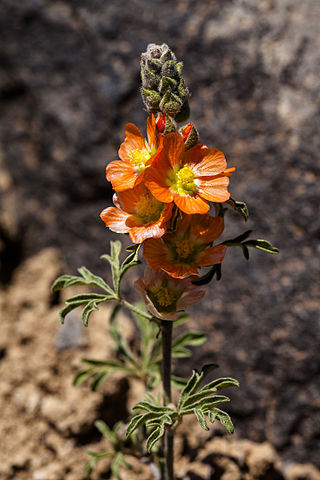
Sphaeralcea coccinea, commonly known as the scarlet globemallow, cowboy's delight, prairie mallow, red false mallow, or simply as globe mallow is a perennial plant growing 10–30 cm tall from spreading rhizomes with a low habit. They have grayish stems with dense, star-shaped hairs and alternately arranged leaves. The leaf blades are 2–5 cm long, palmately shaped, and deeply cut, with 3–5 main wedge-shaped segments. The undersides of the leaves have gray hairs. The 2-cm-wide flowers are reddish-orange and saucer-shaped, with 5 notched, broad petals, in small terminal clusters. Plants flower from May to October.

Oenothera suffrutescens is a species of flowering plant in the evening primrose family known as scarlet beeblossom and scarlet gaura.

Boerhavia coccinea is a species of flowering plant in the four o'clock family which is known by many common names, including scarlet spiderling, red boerhavia, and in Spanish, hierba del cancer and hierba de la hormiga.

Clinopodium nepeta, known as lesser calamint, is a perennial herb of the mint family.
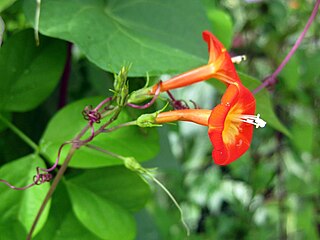
Ipomoea coccinea is a flowering plant in the family Convolvulaceae known by several common names including red morning glory, redstar and (ambiguously) Mexican morning glory.

Haemodorum coccineum is a flowering plant in the same family as kangaroo paw.
Clinopodium mimuloides is a species of flowering plant in the mint family known by the common name monkeyflower savory. It is endemic to California.

Stephensia brunnichella is a moth of the family Elachistidae found in Europe and east into the Palearctic.
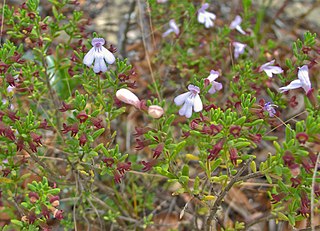
Clinopodium ashei is a species of flowering plant in the mint family known by the common names Ashe's savory and Ashe's calamint. It is native to Florida and Georgia in the United States.

Clinopodium dentatum is a species of flowering plant in the mint family known by the common names toothed savory and Florida calamint. It is native to Florida and Georgia in the United States.

Castilleja coccinea, commonly known as scarlet Indian paintbrush or scarlet painted-cup, is a biennial flowering plant in the Orobanchaceae (broomrape) family. It is usually found in prairies, rocky glades, moist and open woodlands, thickets, and along streams in central and eastern North America.

Clinopodium glabellum, the glade calamint, is a species of flowering plant in the mint family. It is native to the Nashville Basin of Tennessee, the Bluegrass Region of Kentucky, and two counties in Alabama. Within this range, it is found only on wet cedar glades and in seeps along limestone creekbeds. Due to its narrow range and specific habitat requirements, this species is considered vulnerable.
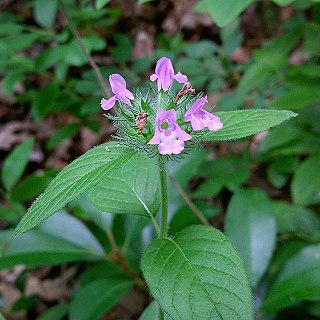
Clinopodium vulgare, the wild basil, is a species of flowering plant in the family Lamiaceae.

Clinopodium menthifolium, commonly known as the wood calamint or woodland calamint, is a species of flowering plant in the mint family, Lamiaceae. It is found throughout southern and central Europe from the United Kingdom and east as far as temperate parts of Asia, and as south as North Africa. It grows up to 1,700 m (5,600 ft) in elevation.


















